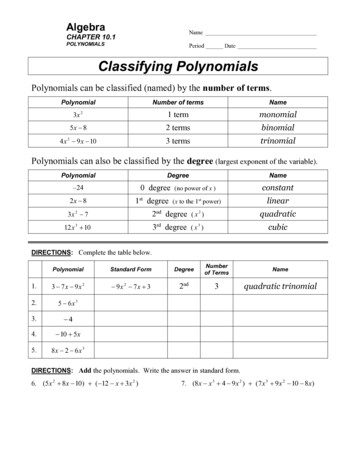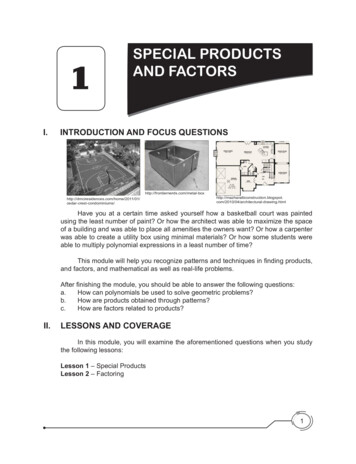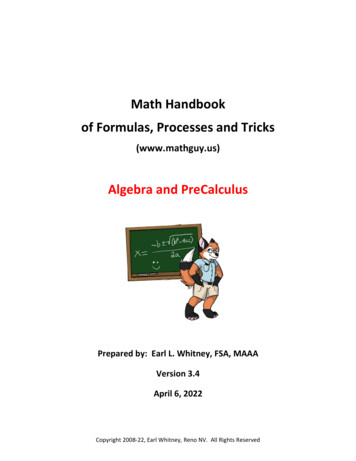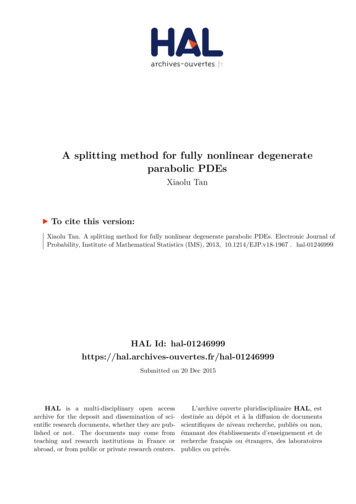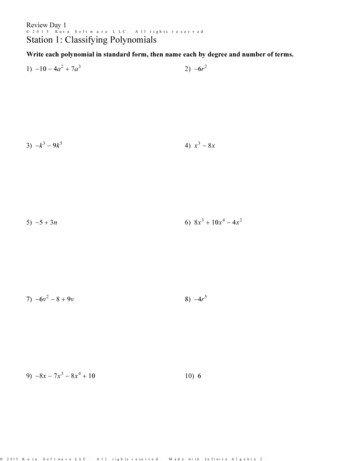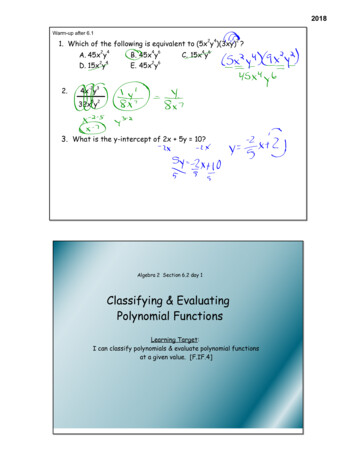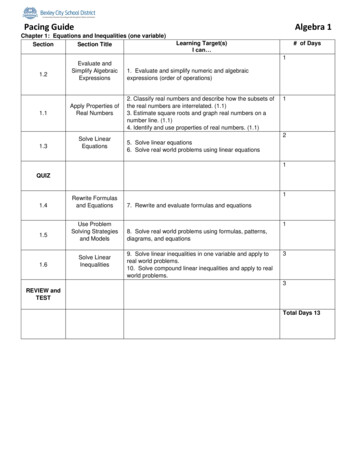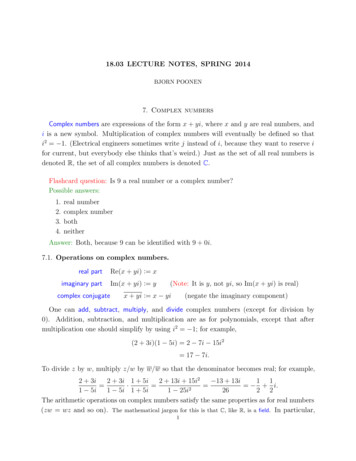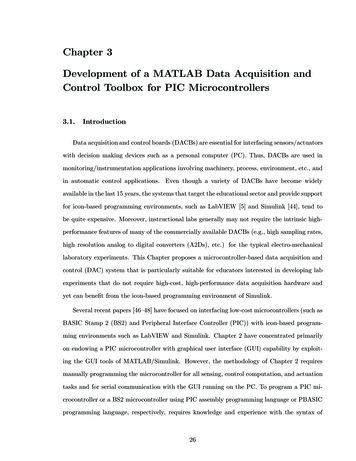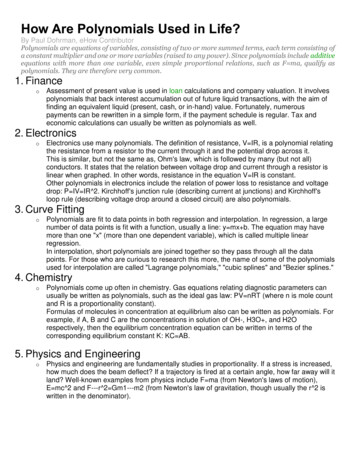
Transcription
How Are Polynomials Used in Life?By Paul Dohrman, eHow ContributorPolynomials are equations of variables, consisting of two or more summed terms, each term consisting ofa constant multiplier and one or more variables (raised to any power). Since polynomials include additiveequations with more than one variable, even simple proportional relations, such as F ma, qualify aspolynomials. They are therefore very common.1. FinanceoAssessment of present value is used in loan calculations and company valuation. It involvespolynomials that back interest accumulation out of future liquid transactions, with the aim offinding an equivalent liquid (present, cash, or in-hand) value. Fortunately, numerouspayments can be rewritten in a simple form, if the payment schedule is regular. Tax andeconomic calculations can usually be written as polynomials as well.2. ElectronicsoElectronics use many polynomials. The definition of resistance, V IR, is a polynomial relatingthe resistance from a resistor to the current through it and the potential drop across it.This is similar, but not the same as, Ohm's law, which is followed by many (but not all)conductors. It states that the relation between voltage drop and current through a resistor islinear when graphed. In other words, resistance in the equation V IR is constant.Other polynomials in electronics include the relation of power loss to resistance and voltagedrop: P IV IR 2. Kirchhoff's junction rule (describing current at junctions) and Kirchhoff'sloop rule (describing voltage drop around a closed circuit) are also polynomials.3. Curve FittingoPolynomials are fit to data points in both regression and interpolation. In regression, a largenumber of data points is fit with a function, usually a line: y mx b. The equation may havemore than one "x" (more than one dependent variable), which is called multiple linearregression.In interpolation, short polynomials are joined together so they pass through all the datapoints. For those who are curious to research this more, the name of some of the polynomialsused for interpolation are called "Lagrange polynomials," "cubic splines" and "Bezier splines."4. ChemistryoPolynomials come up often in chemistry. Gas equations relating diagnostic parameters canusually be written as polynomials, such as the ideal gas law: PV nRT (where n is mole countand R is a proportionality constant).Formulas of molecules in concentration at equilibrium also can be written as polynomials. Forexample, if A, B and C are the concentrations in solution of OH-, H3O , and H2Orespectively, then the equilibrium concentration equation can be written in terms of thecorresponding equilibrium constant K: KC AB.5. Physics and EngineeringoPhysics and engineering are fundamentally studies in proportionality. If a stress is increased,how much does the beam deflect? If a trajectory is fired at a certain angle, how far away will itland? Well-known examples from physics include F ma (from Newton's laws of motion),E mc 2 and F---r 2 Gm1---m2 (from Newton's law of gravitation, though usually the r 2 iswritten in the denominator).
How to Use Polynomials in the Business WorldBy Melissa Bajorek, eHow ContributorPolynomials can be used to forecast sales trends over time.Polynomials are used in the business world in dozens of situations. Polynomials -- algebraic expressionsmade with constants, variables and exponents -- can be used to forecast sales trends, develop profitmargins and attract investors. Polynomials are combined using addition, subtraction and multiplication,but never division.To use polynomials in business, start by working with the simplest forms. The mostbasic polynomials with just one term, called monomials, are used in everyday business.A supervisor can use a polynomial such as 12X, where X represents his average salesin a month, to determine the average sales of a whole year. Polynomials can also helpfigure overhead costs. For example, 12 months of rent may be figured as 12R. You canuse more extensive polynomials to determine, for example, how much profit is left afteraccounting for overhead costs, wages and other liabilities, such as payroll taxes.Once you have mastered the simplest polynomials, try using more-complicated ones foryour payroll. For instance, a polynomial that describes an employee's regular wagesplus 20 hours of overtime may read like:Appendix 1C page 240H 20(H 1/2H) where H is the employees standard hourly pay.A polynomial describing another employee who works part time but earns a 20 percentcommission on sales may read like:20H 0.2SEach of these polynomials uses two terms, making them binomials.For complicated polynomials that will affect whether your business succeeds, getprofessional help. Retail businesses use market research companies to set prices anddevelop pricing strategies over time. Polynomials can be used in a demand equation toshow how much money people will pay for a product, depending on how much of thatproduct is available. A good example is fuel. When fuel prices are low, consumers maybuy much more and use their cars more often. When fuel prices are high (meaning fuelis less available), consumers will curtail their driving habits. So, a demand equation usespolynomials to figure how high or low you can price a product. Marketing companies usethese polynomials to determine that at a certain high price point, no one will purchase aproduct. At a very low price, the items will sell quickly but create no profit.Accuracy is key when using polynomials for business. Many professionals rely onspreadsheet software and graphing calculators to figure more-complicated polynomials.If you plan on using polynomials often, consider taking a few algebra classes andinvesting
What Are Some Careers for Using Polynomials?By Linda Donahue, eHow ContributorLots of careers use mathThe study of algebra (along with other higher math disciplines) revolves around using and manipulatingpolynomials. Polynomials are used in engineering, computer and math based jobs, in management,business and even in farming. In all careers requiring knowledge of polynomials, variables and constantsare used to create expressions defining quantities which are known and unknown. These relationships,between the known and unknown, are balanced in equations then solved for unknown quantities. Anycareer which uses measurement uses quantities.1. Professional CareersoCareers in computer science and mathematical applications depend on algebraic constructs.Consider work as an actuary, or a computer programmer or software engineer.Mathematicians, statisticians and engineers of all sciences employ the use of polynomials.Among engineering career options there are aerospace engineers, chemical engineers, civilengineers, electrical engineers, environmental engineers, industrial engineers, materialsengineers, mechanical engineers and nuclear engineers. Consider also work as a drafter orengineering technician.Scientists, too, use polynomials in their work. Fields include life science, biology, physicalsciences, chemistry, physics and astronomy. Algebra is instrumental in working with data insocial sciences as well. Related social science occupations include working as an economistor a math or science teacher.In the health field, polynomials are used by those who diagnose and treat conditions.Registered nurses, health technologists and technicians, medical records and healthinformation technicians, veterinary technologists and technicians all use algebra in their lineof work.2. Management CareersoManagement occupations often use algebraic polynomials in solving their organizationalbased problems. Management positions include computer and information systemsmanagers, engineering and natural sciences managers, along with farmers, ranchers, andagricultural managers. Even funeral directors, industrial production managers, medical andhealth services managers, and property, real estate, and community association managersall use math in their daily work. Other career paths could lead you to become a purchasingmanager, buyer, or purchasing agent. Business and financial operations occupations, alongwith budget analysts and insurance underwriters all use polynomials.Other CareersoIn the service industry, health care support occupations, such as nursing, psychiatric, andhome health aides required knowledge of polynomials and their uses. Other fields employingalgebra (or calculus, etc.) include farming, forest, conservation, and logging work. Workers ininstallation fields, such as electrical and electronic equipment mechanics, installers, andrepairers benefit from understanding how to work with polynomials. Likewise, that knowledgeis useful to electronic home entertainment equipment installers and repairers. And in the fieldof metal workers and plastic workers, computer control programmers and operators will solveproblems using polynomials.
When Are Polynomials Used in Daily Life?By Brandon Huebner, eHow ContributorPolynomials serve many purposes.Polynomials are a combination of several terms that can be added, subtracted or multiplied but notdivided. They are one of the most basic algebraic operations, and many algebra students may wonderwhy they need to bother learning about them. While polynomials are in sophisticated applications, theyalso have many uses in everyday life.1. Financial PlanningPolynomials can be used in financial planning. For instance, a polynomial equation can beused to figure the amount of interest that will accrue for an initial deposit amount in aninvestment or savings account at a given interest rate. If a savings account with an initialdeposit of 3,000 gains 3 percent interest, then this polynomial equation shows the interestgained for three years: Interest (3,000)(3%)(3). In this situation, the savings account wouldaccrue 270 dollars of interest during the three years.Construction or Materials Planningo Polynomials help in calculating the amount of materials needed to cover surfaces.Polynomials are applied to problems involving construction or materials planning. Apolynomial equation can be used in any 2-D construction situation to plan for the amount ofmaterials needed. For example, polynomials can be used to figure how much of a garden'ssurface area can be covered with a certain amount of soil. The same method applies to manyflat-surface projects, including driveway, sidewalk and patio construction.Expense Budgetingo Polynomials are useful for money matters. Polynomials are useful when it comes tobudgeting or expense planning. When you need to earn a given amount of money within acertain time period, polynomials can help you determine the exact amount of time you needto earn that amount. By predicting your expenses and knowing your rate of income , youeasily can determine the amount of time you need to work. If you need to earn 4,000, canearn 350 per week and your expenses total 75 per week, then the equation is 350x75x 4,000, where x is the amount of weeks needed to work. The equation's solution is 141/2, which means you would need to work 14 1/2 weeks in order to save 4,000.Gravitational Accelerationo The rate at which objects fall can be calculated using polynomials. Polynomials also are usedin scientific problems, including gravitational acceleration problems. The polynomial equationneeds to include the object's initial position, which is its distance from Earth's center, its initialvelocity and its acceleration due to gravity, which is a constant figure. The accepted standardacceleration due to gravity is 32.17 feet per second squared. That is a basic formula, andmany other aspects such as air resistance or air density are factored in by a scientist seekinga highly specific solution.o
Polynomial FunctionsModeling RepresentationPolynomial functions are nothing more than a sum of power functions.As a result, certain properties of polynomials are very "power-like."When many different power functions are added together, however,polynomials begin to take on unique behaviors.To understand polynomial behavior, it is important to separate the longterm from the short term. Long term behavior refers to what apolynomial does far from the origin – with inputs of large absolute value. Short termbehavior refers to what a polynomial does close to the origin – withinputs of small absolute value. The terms "long," "short," "large," and "small," of course,are all relative. They depend very much on the particular polynomial.The long term behavior of a polynomial is very simple: It is indistinguishable from a singlepower function. A polynomial may be composed of many power functions, but one ofthese power functions always, eventually, dominates all of the others. The lesser powerfunctions become insignificant by comparison, and the polynomial settles into the longterm behavior of its dominant term.It is the short term behavior of polynomials that makes them most interesting. Near theorigin, polynomials may wiggle up and down – crossing the x-axis at many roots andhitting many highs and lows – before the dominant power function can take long termcontrol. The area around the origin is the polynomial party shack. All of a polynomial'sexuberance is expressed here.It is this exuberant wiggling that ultimately distinguishes polynomials in modelingsituations:Polynomial functions model data with multiple maxima and minima in the short term,and power trends in the long term.Here are some places to look for a polynomial's peaks and valleys: The stock market. (price vs. time) Water levels in a reservoir. (height vs. time) Demand for electricity. (watts vs. time) The curves of a scalable computer font. (y vs. x) http://www.wmueller.com/precalculus/families/1 50.html
why they need to bother learning about them. While polynomials are in sophisticated applications, they also have many uses in everyday life. 1. Financial Planning o Polynomials can be used in financial planning. For instance, a polynomial equation can be used to figure the amount of interest that will accrue for an initial deposit amount in an
